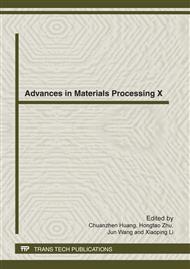p.385
p.391
p.397
p.403
p.410
p.417
p.423
p.429
p.434
FEM Analysis during Extrusion of Round-To-Pentagonal Sections through Converging Dies
Abstract:
The linearly converging die plays a significant role in the extrusion process of section products in terms of reduction in extrusion load and improvement of product quality. With the help of upper bound method based on dual stream function method. Very few investigations have been reported when product and billet geometry are dissimilar using linear converging die. Dual stream function method is incapable of predicting kinematically admissible velocity field in the above case, SERR technique (Spatial Elementary Rigid Region) is the only alternative. In the present investigation, a reformulated SERR technique has been used to determine non-dimensional extrusion pressure and optimum die profile both for frictionless and friction conditions. SERR technique based on discontinuous velocity field is applicable for this case. In the present investigation, non-dimensional extrusion pressure and optimum die length has been determined for extrusion of pentagonal from round billet and the results are compared with the FEA results by using DEFORM 3D.
Info:
Periodical:
Pages:
410-413
Citation:
Online since:
April 2012
Authors:
Price:
Сopyright:
© 2012 Trans Tech Publications Ltd. All Rights Reserved
Share:
Citation:


